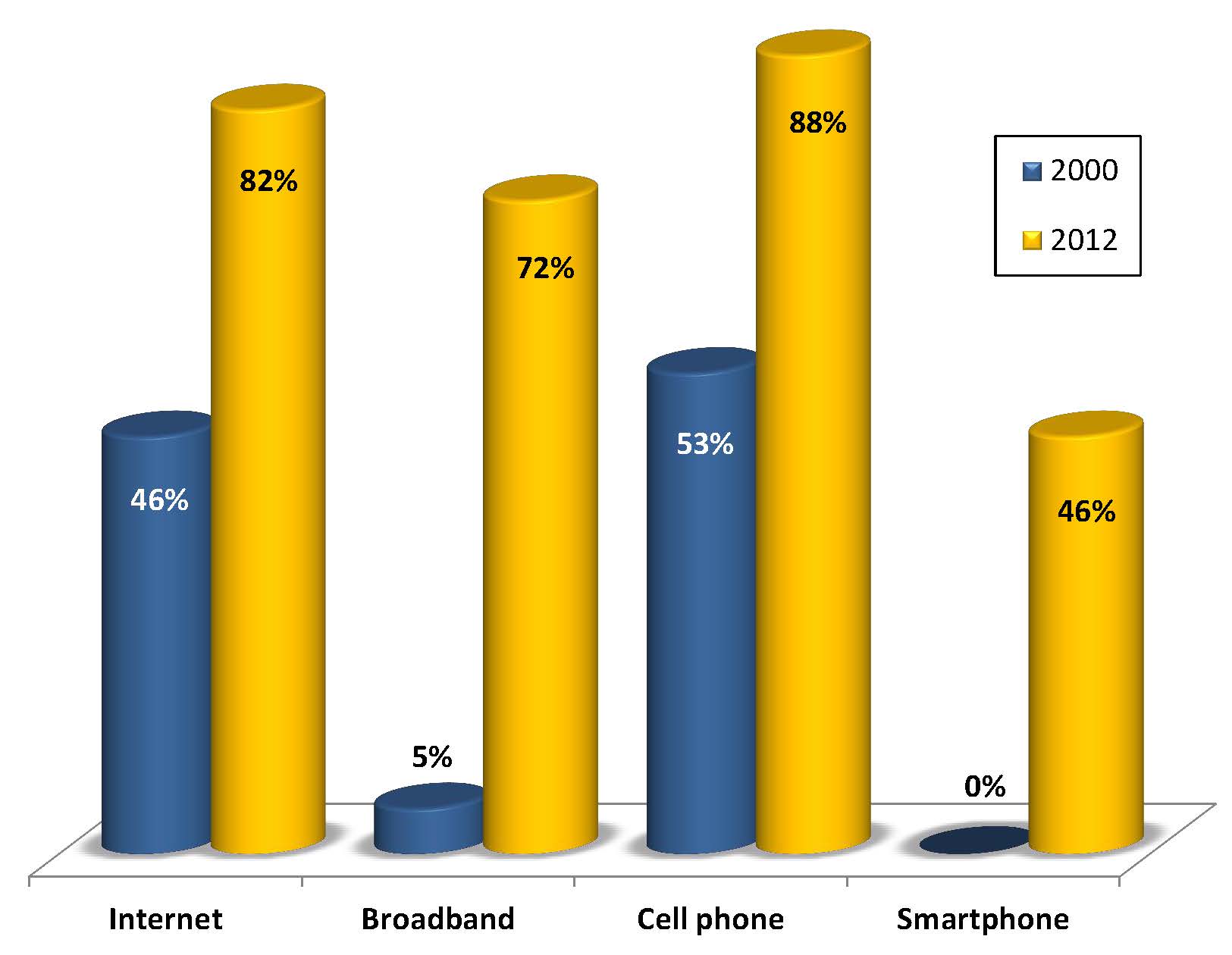
A New Way to Go
The Transportation Apps and Vehicle-Sharing Tools that Are Giving More Americans the Freedom to Drive Less
America is in the midst of a technological revolution ... and a big shift in our transportation habits. New technology-enabled transportation services - including numerous varieties of carsharing, bikesharing, ridesharing and real-time transit information delivered via smartphone - are emerging rapidly, giving an increasing number of Americans the freedom to adopt car-free and car-light lifestyles. A New Way to Go provides a "field guide" to these new services, documents the impacts they are already having on Americans' transportation choices, and highlights their potential to reshape America's transportation system in ways that further reduce driving.
Downloads
America is in the midst of a technological revolution … and a big shift in our transportation habits.
Over the last 15 years, the Internet and mobile communications technologies have transformed the way Americans live and work. During that same period, growth in vehicle travel slowed and then stopped, with Americans today driving about as much on average as we did in 1996.
Both changes have taken place most rapidly among young Americans, who have been the earliest and most enthusiastic adopters of new technologies, as well as the new social networking tools that are the foundation of the emerging “sharing economy.” They have also been the group that has reduced its driving the most, with the average American between 16 and 34 years of age driving a startling 23 percent less in 2009 than in 2001.
Could these developments – the rapid spread of mobile, Internet-connected technologies, the emergence of social networking, and the recent decline in driving – be related? And what does the future hold?
Early evidence suggests that new innovations in technology and social networking are beginning to change America’s transportation landscape. New transportation services are providing people with an abundance of new options, helping to overcome barriers to the use of non-driving forms of transportation, and shifting the economics behind individuals’ travel choices. Collectively, they are also opening up the opportunity for more Americans to adopt “car-free” and “car-light” lifestyles with dramatically less driving.
Figure ES-1. Market Penetration of Major Technologies in 2000 versus 2012[i]

America is in the midst of a technological revolution.
- Between 2000 and 2012, the percentage of adults who use the Internet increased from 46 percent to 82 percent. The percentage of adults who own a cell phone increased from 53 percent to 88 percent. The share of Americans with access to high-speed Internet at home increased from 5 percent to more than 70 percent. And roughly half of Americans now own smartphones, which did not exist in their modern form in 2000.
- These technologies are changing how Americans live and work. Participation in telework and e-commerce has increased dramatically in the last decade. Meanwhile, social networking has helped unleash an emerging “sharing economy” that provides more people with convenient access to mobility that had once been available only to those who owned a car.
- Young Americans have consistently been the first to adopt and test the capabilities of these new technologies and practices. As of September 2012, young adults were six times more likely to have a smartphone than people in their grandparents’ generation, and twice as likely as those between 50 and 64 years of age.
Advances in the Internet and mobile communications technologies have unleashed a wave of new technology-enabled transportation services.
- Carsharing – Classic roundtrip carsharing services, such as Zipcar and City Carshare – as well as newer one-way services such as car2go – enable subscribers to access cars located in their neighborhoods and on their college campuses, providing participants with the mobility benefits of access to a car without having to bear the burden of owning one. As 2012, more than 800,000 Americans were members of carsharing services (sharing a combined fleet of more than 12,000 vehicles). Newer peer-to-peer carsharing networks enable individuals to rent out their own unused vehicles to people looking for a car.
- Bikesharing – Six years after the launch of the first modern bikesharing system in the U.S., more than 30 cities now have programs where subscribers can access bikes by the minute or by subscription at kiosks located on city streets. In just its first season, New York City’s Citibike program enlisted more than 70,000 annual members, with riders traveling more than 4.5 million miles.
- Real–time transportation information – The majority of U.S. transit systems now make scheduling information publicly available, enabling developers to produce a variety of new smartphone apps to help riders navigate urban transportation systems. Smartphone-based tools enable riders to find the best route for their trip, track the progress of trains and buses in real time, and even, in some cases, pay their fare.
- Ridesharing – A variety of new services across the country pair ordinary people with open seats in their cars with individuals who need a ride. Using the Internet and smartphones to facilitate rides enables those seeking shared rides to tap a broader pool of potential matches.
- Taxi and transportation network services – New services enable people to hail taxis or livery vehicles, or to arrange rides with ordinary drivers (e.g., Lyft and Sidecar) via smartphone, making it easier, and often less expensive, to hire a ride.
- Multi-modal tools – New apps and tools also enable individuals to plan trips using several modes of transportation, facilitating efficient, seamless, door-to-door trips.
Technology-enabled transportation services have the potential to change Americans’ transportation behaviors.
- Technology-enabled services can eliminate traditional barriers that prevent Americans from taking public transit or sharing rides and vehicles.
- The array of new services can make it easier for households to reduce the number of vehicles they own – a step that generally leads to steep reductions in driving.
- Technology-enabled services can expand the availability of transportation choices in places and markets where they are not currently available.
- Access to mobile technology also enables riders to use their time riding on trains or waiting for buses more productively. This provides shared transportation with a market advantage over driving, since the use of mobile technology is increasingly understood as being incompatible with the safe operation of a car.
While many of these new tools are in their infancy, several have already been shown to reduce vehicle ownership and driving.
- Each carsharing vehicle replaces nine to 13 privately-owned vehicles, and the average carsharing participant reduces his or her driving by 27 to 56 percent. About 25 percent of carsharing participants sell a vehicle after joining while another 25 percent forgo vehicle purchases they otherwise would have made.
- A study of the Chicago transit system, which gradually introduced a real-time bus location information system from 2006 to 2009, found that introducing real-time information increased weekday bus ridership.
- Approximately 40 percent of bikeshare members report reducing their driving, according to a 2011-2012 survey of members of four North American bikeshare services. A 2013 survey of members of Washington, D.C.’s Capital Bikeshare program found that one quarter reported having reduced the number of miles they drove since joining the service. Five percent of members reported having sold a personal vehicle since joining the service, with 81 percent of those members reporting that joining Capital Bikeshare was a factor in the decision. The total reduction in vehicle travel by Capital Bikeshare members was estimated at 4.4 million miles.
The cumulative impact of new transportation services on vehicle ownership likely exceeds that of the individual services.
- By providing more choices and flexibility for individuals to meet their transportation needs, these new tools can make it convenient to adopt “car-free” and “car-light” lifestyles that dramatically reduce driving.
- Households that reduce the number of vehicles they own often dramatically reduce the number of miles they drive. Because many of the costs of owning a car are perceived to be fixed, vehicle owners perceive the cost of driving an additional mile to be artificially low. New services such as carsharing shift the cost of driving from fixed to per-mile costs, providing an incentive for users to drive less.
- Information technologies make it easier to ensure seamless connections between various modes of transportation, expanding the number and types of trips that can be completed effectively without a car.
Cities, states and the federal government should take a series of immediate steps to unlock the potential of technology-enabled transportation services to provide Americans with more and better transportation choices, while integrating new technologies into transportation planning and policy. Specifically, governments should:
- Use information technology to facilitate the development of technology-enabled services by providing open access to transit scheduling and operations data, providing real-time transit information at stations, bus stops and elsewhere, ensuring wi-fi and/or cellular network access on all transit vehicles, and creating multi-modal connections with emerging transportation services.
- Modernize regulations to accommodate carsharing, bikesharing, ridesharing, and other transportation services in ways that unlock the tremendous potential of these services while ensuring strong protection for consumers and residents.
- Embrace a multi-modal future – Transportation planners should seek to integrate new technology-enabled services and existing transportation services into integrated systems that provide efficient, seamless, door-to-door connections. Officials should incorporate new transportation tools into all aspects of transportation planning and decision-making, while breaking down outdated mode-specific “silos” in transportation agencies and financing. Governments should make strategic investments in tools to integrate and maximize the benefits of new transportation innovations, while also investing in the basic infrastructure – such as transit lines and improved facilities for bicycles and pedestrians – that provides individuals with high-quality transportation choices.
- Extend the use of technology-enabled tools to new communities – Local and state governments should expand access to technology-enabled services to areas beyond the major cities in which they have taken root, surmount economic and other barriers to the use of those alternatives, and explore the potential uses of Internet and mobile communications technologies in expanding access to high-quality public transportation in areas that currently do not have the population density to sustain such service.
- Learn and adapt by tapping the rich information offered by new technologies to improve the quality of transportation services. Local, state and federal officials should also invest in research to explore the impact of recent technological changes on future expectations of demand for driving.
Public officials should also ensure that plans for future transit and road capacity investments adequately reflect the emergence and potential of new technology-enabled tools to reduce driving. Governments should cancel plans for highway expansion projects that no longer make sense amid recent trends toward reduced driving and the emergence of new technologies.
[i] See body of report for citations of data presented in the Executive Summary.
Authors
Tony Dutzik
Associate Director and Senior Policy Analyst, Frontier Group
Tony Dutzik is associate director and senior policy analyst with Frontier Group. His research and ideas on climate, energy and transportation policy have helped shape public policy debates across the U.S., and have earned coverage in media outlets from the New York Times to National Public Radio. A former journalist, Tony lives and works in Boston.
Travis Madsen
Policy Analyst
